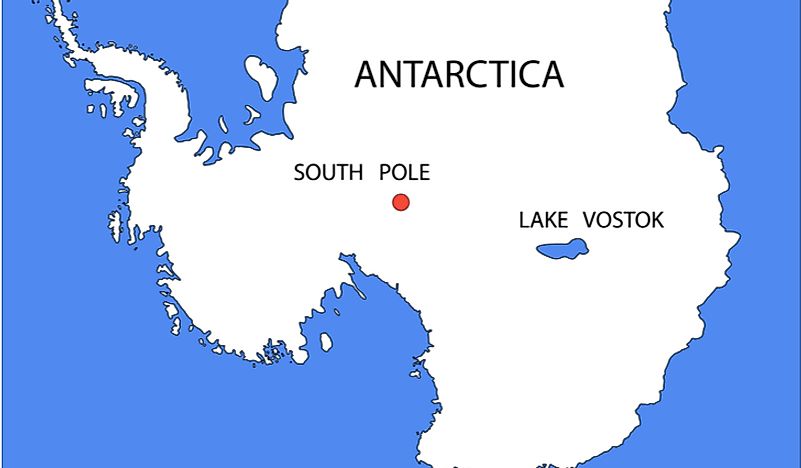Lake Vostok – The Largest Lake in Antarctica

Antarctica is the world's southernmost continent and is located almost completely south of the Antarctic Circle. It is also the coldest, driest, and windiest continent, and approximately 98% of Antarctica is covered by ice that has an average thickness of nearly 2 km. Despite being largely covered in ice, Antarctica contains numerous lakes and rivers. Many of these lakes are subglacial. The largest of the 400 known subglacial lakes in Antarctica is Lake Vostok, which is located beneath Vostok Station, a Russian research station in Prince Elizabeth Land, Antarctica. Lake Vostok is a freshwater lake situated approximately 4,000 m beneath surface of the ice sheet, which means it is approximately 500 m below sea level. The lake has a length of 250 km, a width of 50 km wide at its widest point, and encompasses an area of approximately 12,500 km2. Additionally, the lake has an estimated volume of 5,400 km3, ranking as the sixth-largest lake in the world in terms of volume. The lake was named after Vostok Station, which was named after Vostok, a Russian warship that led the First Russian Antarctic Expedition from 1819 to 1821.
Discovery of Lake Vostok
The idea of freshwater under the Antarctica ice sheets was first proposed by Russian scientist Peter Kropotkin in the late 19th century. Kropotkin suggested that pressure from the cumulative mass of ice could decrease the melting point of the lowest part of the ice sheet to the point that the ice would become liquid water. This theory was later advanced by Russian glaciologist I. A. Zotikov, who completed his Ph.D thesis on the subject in 1967. Russian geographer Andrew Kapitsa later used seismic soundings in the region near Vostok Station to measure the thickness of the ice sheet and became the first person to suggest the possibility of subglacial lakes in the region. In the early 1970s, British researchers conducted airborne radar surveys in the region and discovered peculiar readings that suggested the existence of liquid water lake beneath the ice sheet. These findings were confirmed in 1991 by British remote sensing specialist Jeff Ridley, who published his data in 1993. The lake was then delineated by British and Russian scientists in 1996. An island was discovered at the center of the lake in 2005, and two small lakes were discovered nearby in 2006.
Characteristics of Lake Vostok
Lake Vostok was most likely sealed off by a thick ice sheet approximately 15 million years ago. Researchers initially believed the same water had been in the lake since its formation. However, researchers Robin E. Bell and Michael Studinger from Columbia University's Lamont-Doherty Earth Observatory later proved that the lake's water was continually freezing and getting carried away by moving ice sheets, and then replaced by water created through the cumulative pressure of the ice sheets. As a result, the entire lake water is replaced approximately every 13,300 years. The coldest temperature ever recorded on Earth, which is −89 °C, was observed at Vostok Station on July 21, 1983. The average temperature of the water in Lake Vostok is approximately -3 °C. This temperature is below the normal freezing point because of the high pressure exerted by the ice above. Heat generated from the interior of the Earth warms the lake’s bottom, while the ice sheet above insulates the water from the surface air temperature. Lake Vostok contains very low levels of nutrients, but is supersaturated with nitrogen and oxygen, as it contains 2.5 litres of nitrogen and oxygen for each kilogram of water.











